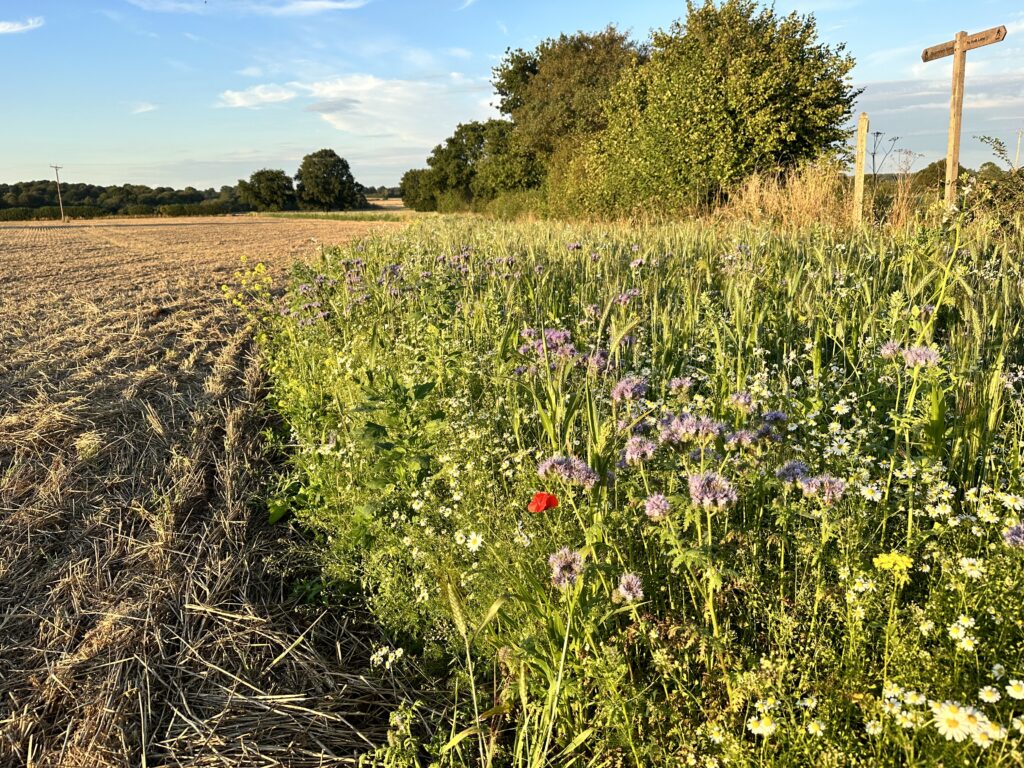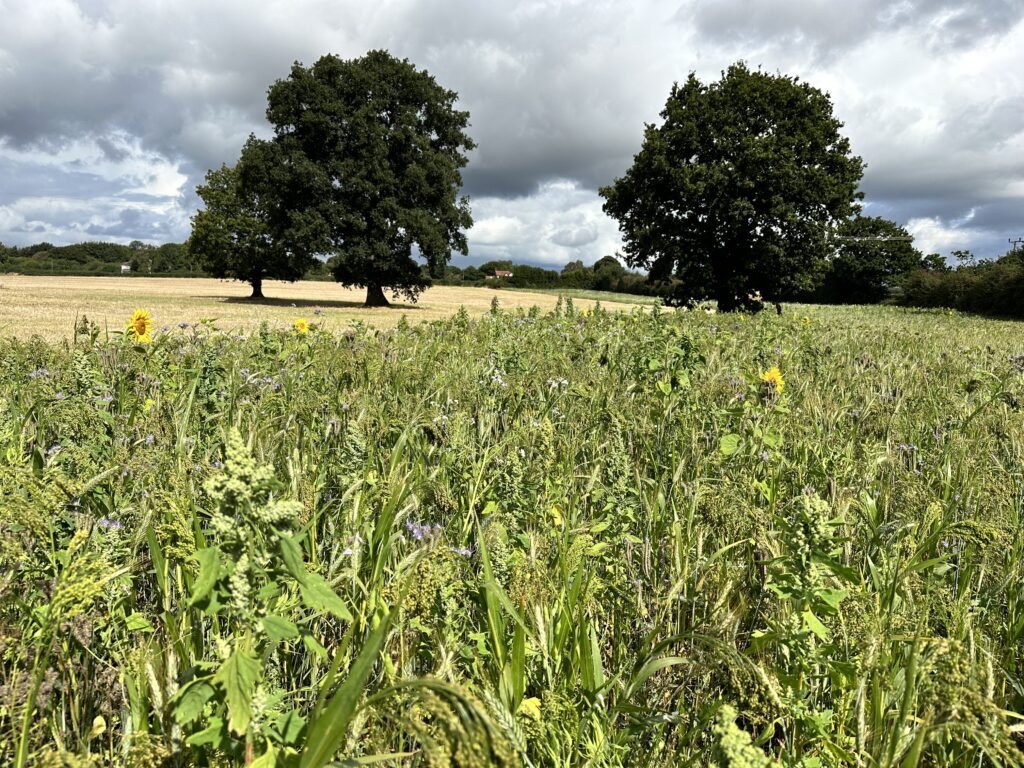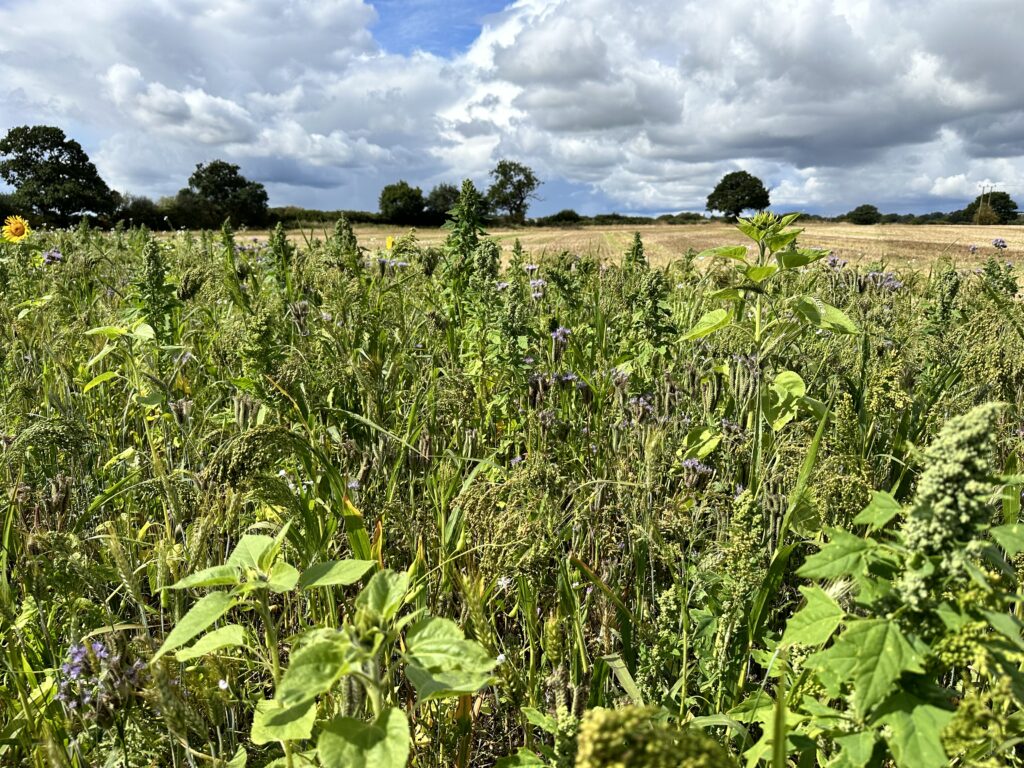October 2023
Sustainable Farm Incentive, my experience and future plan
We joined SFI pilot at the first possible opportunity, our previous entry level scheme consisting of little more that 3m margins, that never really added an awful lot to local biodiversity, had expired 2 years earlier. Countryside stewardship was the natural replacement, it was competitive, and options limited in ways that I felt would both restrict its potential benefit to environment whilst excessively complicating logistics of our rotation and operations. Ultimately, we purposely held back on entering a contract until we felt more clarity existed around the new ELMS schemes that Michael Gove had just announced were coming fearing that an existing stewardship agreement might end up limiting our access to whatever ELMS offered in the future.
When announced, SFI Pilot was only open to farms not already in stewardship so our decision to sit things out and wait seemed well measured. I was excited to get involved, hopeful that as well as reward the improvements to soil, biodiversity and environment made here from investing and already practicing the kind of sustainable farming methods it grabbed headlines outlining, it would also maybe provide solutions to some of the problems we faced, replace the rapidly depreciating BPS payment and just maybe provide the support needed to help us take things up a step to the next level of efficiency, productivity and environmental gain.
My excitement however was met with disappointment, even though our existing practices made compliance with many of the new standards very easy, it offered limited opportunities for either business or environment that I could see. The payment, even for the “advanced” levels we could achieve were nothing to get excited about and certainly fell short of the BPS level of financial support UK farmers have become used to.
Despite the disappointment we still joined, pilot was an opportunity for farmers to feedback and hopefully be part of building a better solution. I have been really impressed by just how much the team at DEFRA seem to have listened and engaged with farmers directly to aid delivery of the best scheme they can offer. They have used feedback and discussion on The Farming Forum and other social media platforms alongside countless farm visits and discussion with groups and individuals to shape what certainly looks like a much better SFI23 offer that what we saw in pilot.

Limitations of the SFI Pilot propelled us to reconsider Countryside Stewardship, with the non-competitive nature offer providing a better fit for our farming operation. This decision necessitated leaving the SFI Pilot and then re-joining the actual SFI, a cumbersome process highlighting the lingering bureaucracy in the application system.
Through harvest year 2023 we established serval countryside stewardship options that are already yielding significant benefit. Options like AB8 and AB9 are extremely tangible in nature looking spectacular flowering though summer months providing amazing, diverse habit for pollinators ahead of the winter feed they will offer farmland birds. They are already being noticed and appreciated by neighbouring residents. It’s been lovely to receive so many positive comments and in less than a year and these options are without doubt already adding to local biodiversity.
Whilst income from our non-rotational stewardship options covers income forgone on less productive land such as field corners and margins it falls short of compensating the gross margin of cereal cash crops. Something I have felt historically has been missing from both CS and SFI is are options that could potentially provide viable alternative to increasingly high risk and low margin break crops such as OSR, beans and Linseed whilst encouraging wider adoption of the winter and summer cover crops we have seen are so beneficial to both soil and environment.
Often referred to as “wish crops” (either wishing you hadn’t planted them or wishing you planted more) the viability and reliability of these crops has become a challenge for many farmers in recent years.
OSR seems increasingly difficult to establish, our approach here has been to use high rates of farm saved seed along with cheap companions like beans and linseed to limit our risk against pests such as CSFB over which we have no realistic ability to control. It’s been a reasonably successful approach, although aspirations of once possible 5t/ha crops seem distant memory even when luck is on side.
Likewise, beans are an extremely weather dependant crop with yield variation here as much as 8t-1t/ha purely dependent upon spring and summer rainfall. Neither crop can be grown to frequently either without build-up of pathogen such as club root or nematode. Climate and pest issues aside the truth is over the last 50 years our soils are just starting to get a little tired of growing these same break crops so often.
Diversity is the single most important aspect of a sustainable farming system, so we have tried alternative break crops including linseed, oats, peas, lupins, millet and even soya. Although all have served valuable agronomic purpose, none have consistently performed and often struggled to find reliable and viable markets and gross margin.

SFI 23 offers options such as AHL2 and NUM3 that finally offer risk free rotational options that compete with break crops gross margins whilst offering the environmentally gain the scheme has been designed to provide. It’s clear however that you must think laterally with SFI – it’s not prescriptive like we have been used to in the past, it’s all about achieving aims, not being told what to do. I think that’s rather refreshing and why I’m such a fan of this scheme, finally it seems to acknowledge that maybe farmers know how to achieve aims best.
History makes it hard to trust however, a theme clear to see in post on The Farming Forum, there is a lot of irony seeing farmers who for years have told DEFRA to let them get on with things as they know their farm best now asking for detail on how? what? and when? exactly they should achieve standard aims, the answer of “it’s up to you” received with a great deal of understandable scepticism.
Defra don’t seem to want to administer SFI with a stick, it feels to me like we are being trusted to do what we think is best and they are aiming for more of a “carrot” approach, policing standards with help and advice rather than retrospective penalties, I hope my assessment of this is correct and trust can be built on both sides to really make this new scheme bring sustainability to farms and environment whilst really delivering the natural capital and public goods to the tax payers who fund this.
The SFI23 scheme is quite simple to apply for and the quarterly payments welcome for cashflow, the complications of compatibility with existing stewardship schemes although well explained in the handbook does add complexity and things would be a lot simpler if existing CS agreements could be rolled into SFI, something that I am told DEFRA are working towards. The printable handbook was something I asked Janet Hughes direct for in front of an audience at this years Cereals event and appeared a week later really is very helpful reference when planning options, they really do seem to listen to feedback!
My plan is now to de risk using AHL2 as our break in a wheat/barley/AHL2 rotation. Dropping the unreliable high risk OSR and Bean break crops we current grow in favour of the certainty of a AHL2 £732/ha payment. Established direct and quickly after winter barley I think carefully selected species should achieve the standards first aim of feeding farmland birds in winter months. It can be terminated in March / April providing a great opportunity to get on top of grassweed issues, then the area would have a multispecies flowering mix established through summer to achieve the second aim of pollinator habitat. The cost of effectively establishing a crop twice in a AHL2 year would be somewhat mitigated by the improvements to soil health and fertility that I know summer cover crops can bring resulting in significant increase in yields of following wheat and barley crops grown with less dependence on synthetic inputs.
The benefits that pulses bring to my soils will not disappear however as I plan to companion crop both my wheat and barley cash crops with beans, peas and phacelia attracting the IPM3 payment on top of the IPM4 we will receive by not using insecticides, something we have been able to do without for the last 15yrs now anyway.
Add in the payments on offer for IPM1 (pest management plan) and SAM1 (soil assessment and plans) the hedgerow and tree options HRW1,2 & 3 and it all starts to look a lot more exciting that the disappointing pilot ever did even before the soon to be announced payment for Direct drilling and precision farming standards are announced (rumoured to be announced soon). With CS payments from my AB8 and AB9 margins and corners, commercial carbon market sales plus a couple years of 50% BPS rate still to come allowing capital investment in further innovation and change I feel DEFRA have this right as an offering to arable farmers and it lays a pathway for an exciting new future of farming where output from food production sits alongside output from natural capital that will truly transform biodiversity and environment for the better.


